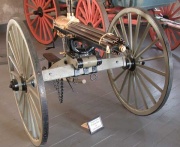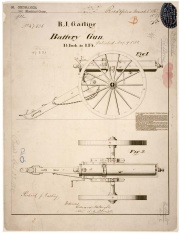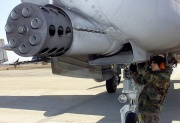Gatling gun
The Gatling gun is considered by some to have been the very first machine gun: although it did not automatically reload under its own power, it was capable of firing continuously. Each barrel fires a single shot as it reaches a certain point in the cycle after which it ejects the spent cartridge, loads a new round, and in the process, somewhat cools down. This configuration allowed higher rates of fire without the problem of an overheating single barrel. The Maxim gun, invented in 1884, was the first self-powered machine gun. The first Gatling gun relied on a hand crank for external power. Some time later, Gatling-type weapons were invented that diverted a fraction of gas from the chamber to turn the barrels. Later still, electric motors supplied external power. The gun was designed by the American inventor Dr. Richard J. Gatling in 1861 and patented in 1862.
Contents |
History
The original Gatling gun was a black powder field weapon, which used multiple rotating barrels turned by a hand crank, and firing loose (no links or belt) metal cartridge ammunition using a gravity feed system from a hopper. The Gatling gun's innovation lay neither in the rotating mechanism (featured by many revolvers of the day) nor the use of multiple barrels to limit overheating (used by the Mitrailleuse gun); rather, the innovation was the gravity feed reloading mechanism, which allowed unskilled operators to achieve a relatively high rate of fire.
The Gatling gun was first used in warfare during the American Civil War. The gun was not accepted by the Union Army until 1866, but a "sales engineer" of the manufacturing company demonstrated it in combat.[1] Lieutenant A.L. Howard of the Connecticut National Guard had an interest in the company manufacturing Gatling guns, and took a personally-owned Gatling gun to Saskatchewan in 1885 for use against the Métis during Louis Riel's North-West Rebellion.[1]
Early multi-barrel guns were approximately the size and weight of artillery pieces, and were often perceived as a replacement for cannon firing grapeshot or cannister shot.[1] Unlike earlier weapons such as the Mitrailleuse which required manual reloading, the Gatling gun was more reliable, easier to operate, and had a higher firing rate. The large wheels required to move these guns around required a high firing position which increased the vulnerability of their crews.[1] Sustained firing of gunpowder cartridges generated a cloud of smoke making concealment impossible until Smokeless powder became available in the late 19th century.[2] When fighting troops of industrialized nations, Gatling guns could be targeted by artillery they could not reach and their crews could be targeted by snipers they could not see.[1]
The Gatling gun was used most successfully to expand European colonial empires by killing warriors of non-industrialized societies including the Matabele, the Zulu, the Bedouins, and the Dervish.[1] Imperial Russia purchased 400 Gatling guns and used them against Turcoman cavalry and other nomads of central Asia.[3] The Royal Navy used Gatling guns against the Egyptians at Alexandria in 1882.[2]
Gatling guns were used by the US side during the Spanish-American War, most notably during the battle of San Juan Hill.[4]
Modern Gatling-style guns
After Gatling guns were replaced by lighter, cheaper blowback-style weapons, the approach of using multiple rotating barrels fell into disuse for many decades. However, Gatling gun-style weapons made a return in the 1940–50s, when weapons with very high rates of fire were needed in military aircraft. For these modern weapons, electric motors are used to rotate the barrel, although systems that derive power from their ammunition do exist such as the GSh-6-23, which uses a gas-operated drive system.
One of the main reasons for the resurgence of the Gatling gun-style design is the weapon's tolerance for continuous high rates of fire. For example, if 500 rounds were fired at a high rate from a conventional single-barrel weapon, this would likely result in the barrel overheating (distorting in extreme cases) or a weapon jam. In contrast, a five-barreled Gatling gun-style weapon firing 500 rounds, only fires 100 rounds per barrel, an acceptable rate of fire. Ultimately the limiting factor is the rate at which loading and extraction can occur. In a single barrel design these tasks must alternate, a multiple barrel design on the other hand lets them occur simultaneously, with different barrels at different points in the cycle. Their high rate of fire also makes them useful in systems that have little time to engage their targets, such as CIWS which defend against fast-moving anti-ship missiles.
The M61 Vulcan 20 mm cannon is the most prolific member of a family of weapons designed by General Electric and currently manufactured by General Dynamics. It is a six-barreled rotary cannon capable of more than 6,000 rounds per minute. Similar systems are available ranging from 5.56 mm to 30 mm (there was even a 37 mm Gatling on the prototype T249 Vigilante AA platform); the rate-of-fire being somewhat inversely-proportional to the size and mass of the ammunition (which also determines the size and mass of the barrels).
Another Gatling design well-known among aviation enthusiasts is the GAU-8 Avenger 30 mm cannon, carried on the A-10 Thunderbolt II (Warthog) attack aircraft. It is a seven-barreled cannon designed for tank-killing and is currently the largest bore Gatling weapon active in the U.S. arsenal.
During the Vietnam War, the 7.62 mm caliber M134 Minigun was created as a helicopter weapon. Able to fire 6,000 rounds per minute from a 4,000-round linked belt, the Minigun proved to be one of the most effective non-explosive projectile weapons ever built and is still used in helicopters today.
They are also used on USAF AC-47, AC-119 and Lockheed AC-130 gunships, their original high-capacity cargo airframes able to house the items needed for sustained operation. With sophisticated navigation and target identification tools, Miniguns can be used effectively even against concealed targets. The crew's ability to concentrate the Gatling's fire very tightly produces the appearance of the 'Red Tornado'[5] from the light of the tracers, as the gun platform circles a target at night.
The minigun features in several action movies including Terminator 2 and Predator, but in reality they are unusable as unmounted personal weapons, the high rate of fire (with accompanying recoil), mechanical and power-supply complexity and heavy weight making them impractical compared to a light machine gun.[6]
Citations and notes
- ↑ 1.0 1.1 1.2 1.3 1.4 1.5 Emmott, N.W. "The Devil's Watering Pot" United States Naval Institute Proceedings September 1972 pp.70
- ↑ 2.0 2.1 Emmott, N.W. "The Devil's Watering Pot" United States Naval Institute Proceedings September 1972 pp.72
- ↑ Emmott, N.W. "The Devil's Watering Pot" United States Naval Institute Proceedings September 1972 pp.71
- ↑ Gatling
- ↑ AC-119K Stinger Gunship Photo 1
- ↑ Mischa & Kitsune [1] General Electric XM214 Minigun
References
- Mischa & Kitsune, The Netbook of modern firearms, http://www.kitsune.addr.com/Firearms/Firearms.htm
See also
External links
- List of Military Gatling & Revolver cannons
- U.S. Patent 36,836 -- Gatling gun
- U.S. Patent 47,631 -- improved Gatling gun
- U.S. Patent 112,138 -- revolving battery gun
- U.S. Patent 125,563 -- improvement in revolving battery guns
- "Colt 30 Cal Gatling Gun Model 1900 Army" drawings
- Description of operating principle (with animation) from HowStuffWorks
- CGI animated GAU-17/A
- THE GATLING BATTERY GUN ON A CAMEL 1872



